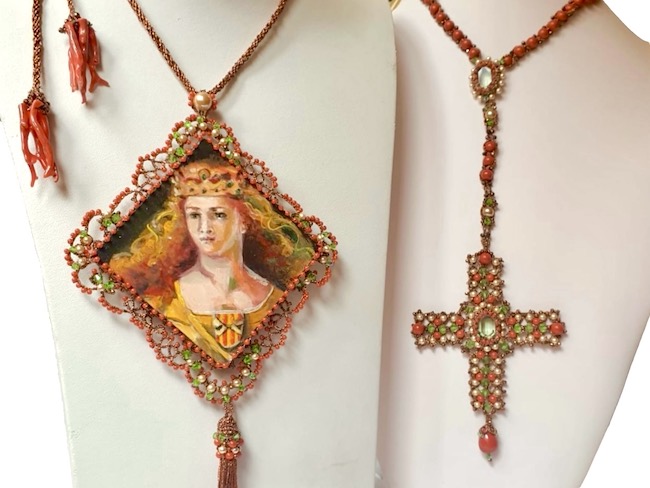Andare avanti e affrontare il presente significa spesso aver bisogno del conoscere le radici che hanno condotto l’essere umano nel punto in cui si trova nel momento attuale, in particolar modo per ciò che concerne il mondo artistico, inteso nel senso più ampio del termine, dove le tracce segnate negli anni più lontani hanno generato evoluzioni e personalizzazioni giunte fino ai tempi moderni sotto forma di libertà espressiva e di possibilità di contaminazione tra i vari stili per dar vita a linguaggi sempre unici e innovativi. La serie Donne di Gemme sul Filo, ideato da Giulia Crimaldi, pittrice, e Rosa Mandina, per trenta anni restauratrice e poi ideatrice e produttrice di gioielli tessili, guarda verso il passato sia per i soggetti femminili che hanno scelto di rendere protagonisti, sia per un approccio artistico che affonda le radici alla fine del Diciannovesimo secolo.
Intorno alla fine dell’Ottocento si delineò, inizialmente in Inghilterra, una nuova tendenza, quella cioè di rivalutare il lavoro artigianale associandolo all’unicità e alla maestria dell’arte, così che molti creativi decisero di avvicinarsi alle lavorazioni artigianali decorando borse, tessuti, tappeti metalli per opporsi alla spersonalizzazione dell’industrializzazione che aveva appiattito l’uomo al servizio delle macchine; nell’Arts and Crafts invece, questo il nome del nuovo stile artistico fondato da John Ruskin e William Morris, si voleva rivalutare l’eccellenza e l’originalità del lavoro dell’uomo, elevando così l’artigianato a un livello più alto di quello precedente e riproponendo il concetto medievale di corporazione delle arti. Le linee guida degli inglesi furono poi riprese e adattate all’individualità di ogni nazione europea, dove il movimento assunse nomi diversi sulla base del paese di appartenenza: Art Nouveau in Francia, Stile Liberty in Italia, Secessionismo in Austria, Modernismo in Spagna e Jugendstil in Germania. Tutti però mescolarono arte e artigianato come se questo sodalizio fosse un continuum reciproco perché in quel periodo chiamato Belle Epoque lo stile di vita sfarzoso e piacevole inseguiva la bellezza e l’aspetto decorativo in ogni manifestazione quotidiana. Dunque vetrate, gioielli, cristalli, mobili, cancelli, architettura, tutto doveva avere un aspetto originale, armonioso, stimolando così i grandi rappresentanti di questo stile a misurarsi con differenti materiali e avvalendosi del supporto di maestri artigiani; in quell’epoca pertanto emersero grandi nomi nel settore della decorazione e della produzione di oggetti che si associarono a quelli dei principali interpreti nel campo più ristretto dell’arte. Accanto a Gustav Klimt, Alfons Mucha, Henri de Toulouse-Lautrec, Galileo Chini, considerati i massimi rappresentanti dell’Art Nouveau, acquistarono fama e notorietà anche celeberrimi artigiani che seppero infondere nelle loro produzioni la medesima originalità ed eccellenza degli artisti, come Emil Gallé che ideò una meravigliosa linea di vasi di vetro, Luis Comfort Tiffany che si dedicò alla creazione di lampade e vetri decorati, i celeberrimi architetti Victor Horta, in Belgio, e Antoni Gaudí in Spagna, per finire alla creazione in Germania della Vereinigte Werkstätten für Kunst im Handwerk e poi la Deutscher Werbund, veri e propri laboratori uniti per arti e mestieri dove tutti i componenti interagivano per dare vita a prodotti completi che potessero portare l’arte e la bellezza nelle case delle persone.
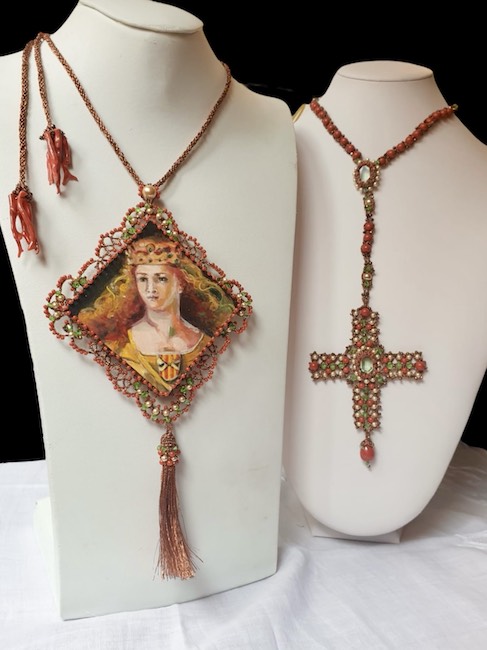
Il progetto Donne di Gemme sul Filo nasce seguendo le linee guida di questo movimento che si diffuse in Europa più di un secolo fa, introducendo un’altra tecnica artigiana di lunga e storica tradizione in Italia, quella del merletto, e pensando alla donna poiché Giulia Crimaldi e Rosa Mandina hanno scelto di dar vita a originali e affascinanti gioielli dove l’abilità della seconda nella realizzazione del merletto chiacchierino si unisce al talento pittorico della prima; non solo, la loro linea creativa costituisce un’ulteriore dedica e celebrazione alla figura femminile poiché i soggetti sono principesse, regine, nobildonne che sono divenute personalità di spicco nel Regno delle due Sicilie, luogo di origine di entrambe le artiste.
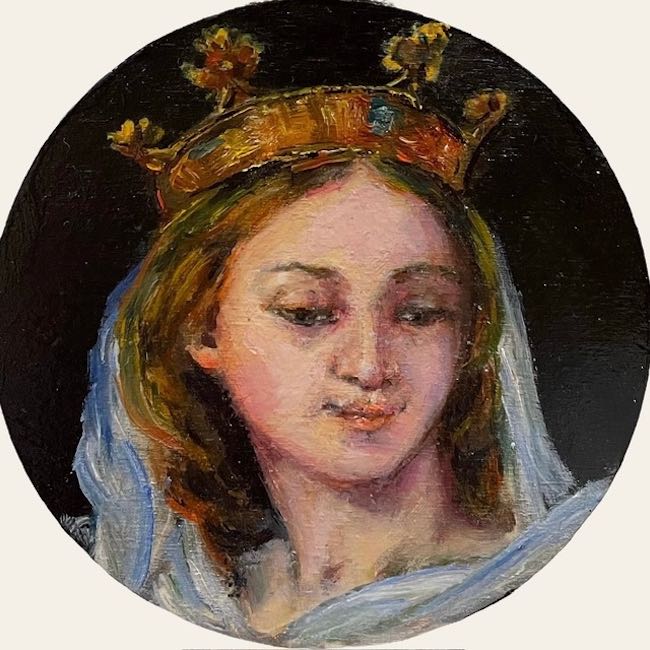
I gioielli sono così composti da piccoli cammei in legno dipinti a olio, raffiguranti i volti delle protagoniste di quelle epoche lontane, che vengono montati su merletto chiacchierino lavorato a mano, ricamati con corallo, perle e cristalli di Boemia; in questo modo gli sguardi, che grazie all’abilità figurativa di Giulia Crimaldi riescono a esprimere la personalità di ciascuna di quelle principesse e regine in grado, tutte, di uscire dall’ombra del loro ruolo istituzionale di consorti per lasciare un importante segno nelle città e nel popolo con cui sono entrate in contatto, vengono esaltati dalla maestria esecutiva di Rosa Mandina che non solo esegue con talento il complesso merletto ma vi inserisce anche elementi grazie ai quali quest’ultimo viene impreziosito.
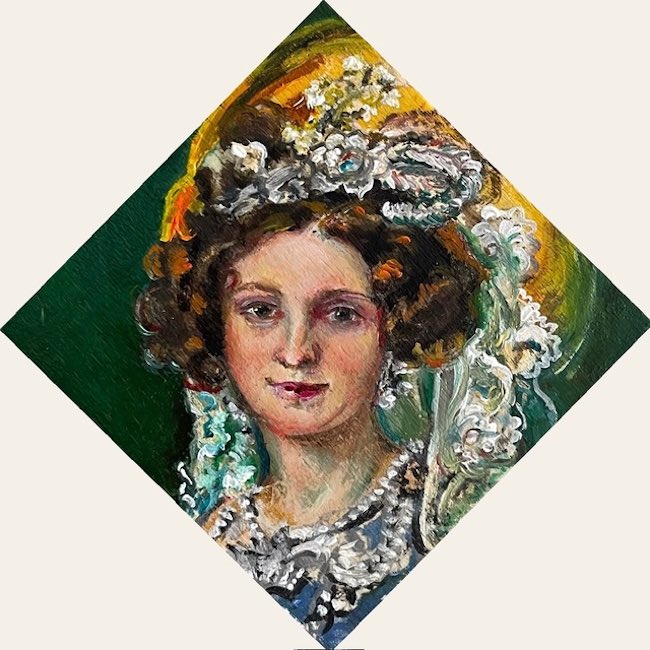
L’idea nasce dalla spinta Arts and Crafts di unire due stili completamente differenti eppure in grado di dare un punto di vista originale e accattivante a gioielli che possono divenire una tendenza, quella appunto di indossare una memoria del passato per non dimenticare mai quanti progressi sono stati compiuti da allora dalle donne, e al contempo per celebrare le coraggiose personalità, alcune delle quali hanno preso in mano il regno e il casato quando è stato necessario, gestendo complessi rapporti esterni.
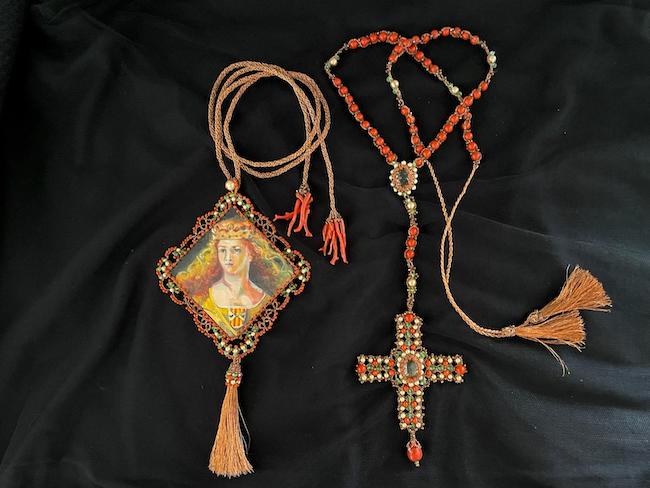
Il Cammeo Donna Eleonora per esempio, è dedicato a Eleonora d’Angiò, conosciuta anche come Eleonora di Sicilia, principessa angioina del Regno di Napoli, terza figlia femmina di Carlo Il d’Angiò, re di Sicilia, e di Maria d’Ungheria, che fu regina consorte del Regno di Sicilia andando in sposa a Federico III d’Aragona, dal 1296 re di Trinacria. Il carattere di questa regina si era formato attraverso un’educazione angioina di forte tradizione cristiana, soprattutto di appoggio agli ordini religiosi come i benedettini e i francescani. Nel 1329 la regina ha poi fondato il convento francescano con annessa la chiesa di S. Maria Immacolata a Catania; Giulia Crimaldi la ritrae in tutta la sua solida e imponente regalità, consapevole dell’importanza del suo ruolo e pertanto desiderosa di importare i suoi valori all’interno del suo regno, ma anche di fare qualcosa di concreto per sostenere la chiesa, parte essenziale della sua educazione. Il merletto realizzato da Rosa Mandina e poi il corallo e le perle inserite in esso, sono perfettamente in armonia con le tonalità scelte per il dipinto miniaturizzato.
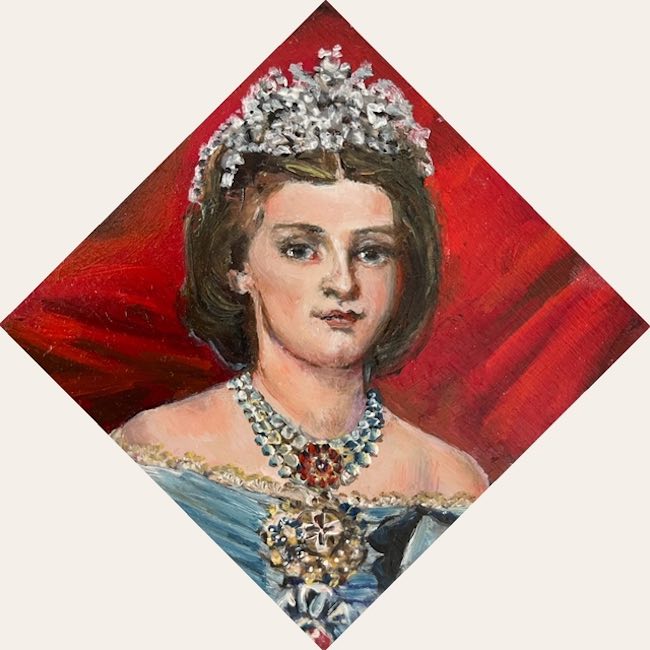
E ancora Cammeo Donna Maria Sofia, sposa di Francesco II di Borbone, duca di Calabria ed erede al trono del Regno delle Due Sicilie, una ragazza emancipata e anticonvenzionale che adorava cacciare e cavalcare, snobbando spesso le severe regole della corte bavarese, forse anche a causa della decisione della sua famiglia di prometterla in sposa appena diciassettenne a un uomo che neanche conosceva personalmente, avendolo visto solo in un ritratto in miniatura. Maria Sofia di Baviera fu l’ultima principessa europea a sposarsi per procura e il suo matrimonio fu necessario per rafforzare il legame tra la corte bavarese e quella borbonica. La donna divenne regina a soli 18 anni e probabilmente fu questo a indurla a divenire ribelle e fuori dagli schemi affermando la sua personalità. Il cammeo la ritrae con la sua corona, con la sfarzosità dei suoi abiti ma ne fa fuoriuscire anche il carattere determinato e l’intenzione di non sottomettersi completamente ai rigidi schemi regali.
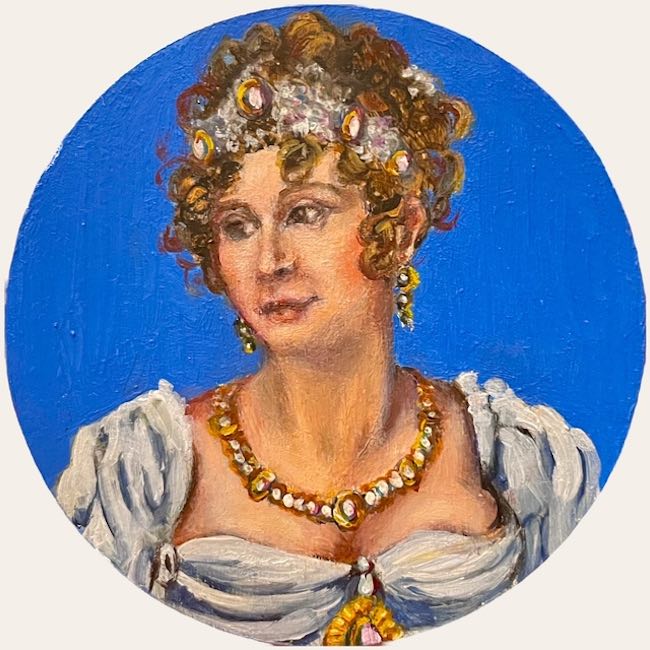
Giulia Crimaldi, pittrice con un percorso esposito di rilievo sia in Italia che all’estero, e Rosa Mandina, restauratrice per professione e anche per attitudine a riportare in vita tesori del passato rimanendo in ombra ma poi scegliendo di esprimere la propria personalità artistica dando vita alla linea di gioielli tessili denominata Gemme sul Filo che si lega alle radici storico-culturali siciliane applicando la maestria manuale nel merletto alla creatività di dar vita a oggetti unici in grado di adornare i colli delle donne, mettono in luce così le differenti caratteristiche di donne che sono state rilevanti per eredità familiare ma che al contempo hanno saputo mostrare il loro lato umano, la loro attitudine a migliorare la vita dei popoli governati dai loro mariti lasciando patrimoni culturali, o semplicemente traccia del loro passaggio.
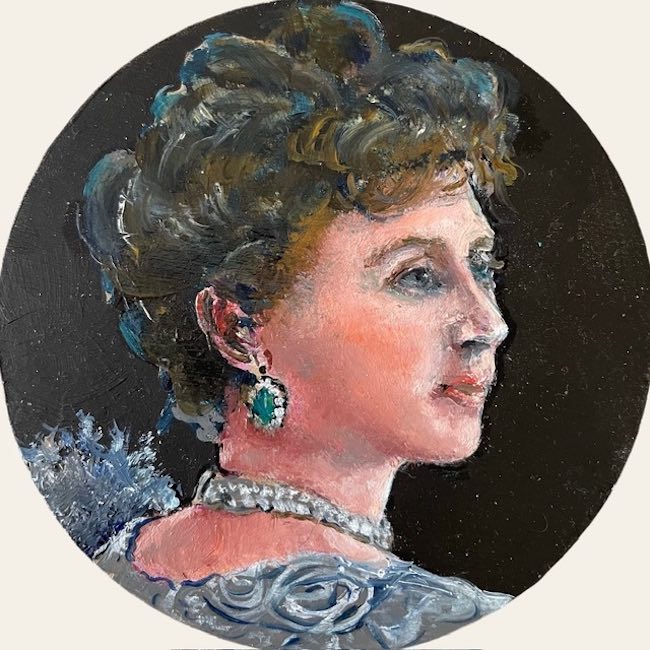
Grazie al progetto Donne di Gemme sul Filo dunque, altre donne potranno scegliere di indossare immagini di un passato essenziale per cominciare a spianare la strada di un’emancipazione femminile che ha raggiunto il suo apice e la sua realizzazione solo dopo la seconda metà del Novecento; ricordare e scegliere la principessa più affine alle proprie caratteristiche può essere dunque un momento di introspezione e di decisione su quale dovrà essere l’ispirazione che l’acquirente vorrà portare con sé. I prodotti si ispirano alla Sicilia, per costituire un ricordo della grandezza di quella terra e per indurre chiunque noti queste preziose gemme di storia a portarsi a casa una vera e propria biografia di una delle protagoniste di tempi lontani.
GEMME SUL FILO-CONTATTI
Email: gemmesulfilo@gmail.com
giulia.crimaldi@gmail.com
Facebook: www.facebook.com/gemmesulfilo
Instagram: www.instagram.com/gemmesulfilo
The iconisation of noblewomen and princesses of the past in Giulia Crimaldi and Rosa Mandina’s Arts and Crafts project
Moving forward and facing the present often means needing to know the roots that have led human beings to where they are at the present time, especially as regards the world of art, understood in the broadest sense of the term, where the traces marked in the most distant years have generated evolutions and personalisations that have come down to modern times in the form of expressive freedom and the possibility of contamination between various styles to give life to languages that are always unique and innovative. The series Donne by Gemme sul Filo, devised by Giulia Crimaldi, a painter, and Rosa Mandina, for thirty years a restorer and then a designer and producer of textile jewellery, looks to the past both for the female subjects they have chosen to make protagonists, and for an artistic approach that has its roots in the late 19th century.
Around the end of the 19th century, emerged a new trend, initially in England, that of revaluing craftsmanship by associating it with the uniqueness and craftsmanship of art, so that many creatives decided to approach handicrafts by decorating bags, fabrics, metal carpets to oppose the depersonalisation of industrialisation that had flattened man at the service of machines; instead in Arts and Crafts, this was the name of the new artistic style founded by John Ruskin and William Morris, the aim was to re-evaluate the excellence and originality of man’s work, thus elevating craftsmanship to a higher level than before and re-proposing the medieval concept of a guild of the arts. The guidelines of the English were then taken up and adapted to the individuality of each European nation, where the movement took on different names according to the country it belonged to: Art Nouveau in France, Stile Liberty in Italy, Secessionism in Austria, Modernism in Spain and Jugendstil in Germany. All of them, however, mixed art and craftsmanship as if this association was a mutual continuum because in that period called the Belle Epoque, the opulent and pleasurable lifestyle pursued beauty and the decorative aspect in every daily manifestation. So stained glass, jewellery, crystal, furniture, gates, architecture, everything had to have an original, harmonious appearance, thus stimulating the great representatives of this style to measure themselves with different materials and avail themselves of the support of master craftsmen; at that time, therefore, emerged great names in the field of decoration and the production of objects that joined those of the main interpreters in the narrower field of art.
Alongside Gustav Klimt, Alfons Mucha, Henri de Toulouse-Lautrec, Galileo Chini, considered to be the greatest representatives of Art Nouveau, also gained fame and notoriety craftsmen who were able to infuse their productions with the same originality and excellence as the artists, such as Emil Gallé who created a wonderful line of glass vases, Luis Comfort Tiffany who dedicated himself to the creation of lamps and decorated glass, the celebrated architects Victor Horta in Belgium and Antoni Gaudí in Spain, and finally the creation in Germany of the Vereinigte Werkstätten für Kunst im Handwerk and then the Deutscher Werbund, true united workshops for arts and crafts where all the components interacted to create complete products that could bring art and beauty into people’s homes. The project Donne by Gemme sul Filo was born following the guidelines of this movement that spread through Europe more than a century ago, introducing another artisan technique with a long and historic tradition in Italy, that of lace, and thinking about women because Giulia Crimaldi and Rosa Mandina have chosen to create original and fascinating jewellery where the latter’s skill in chiacchierino lace is combined with the former’s pictorial talent; not only that, their creative line constitutes a further dedication and celebration of the female figure since the subjects are princesses, queens, noblewomen who became prominent personalities in the Kingdom of the Two Sicilies, the place of origin of both artists.
The jewellery is thus composed of small oil-painted wooden cameos, depicting the faces of the protagonists of those distant epochs, which are mounted on hand-worked tatting lace, embroidered with coral, pearls and Bohemian crystals; in this way the gazes, which, thanks to Giulia Crimaldi‘s figurative skill, succeed in expressing the personality of each of those princesses and queens who were all able to step out of the shadows of their institutional role as consorts to leave an important mark on the cities and people with whom they came into contact, are enhanced by the craftsmanship of Rosa Mandina, who not only executes the complex lace with talent but also inserts elements to embellish it. The idea stems from the Arts and Crafts urge to unite two completely different styles that are nevertheless able to give an original and captivating point of view to jewellery that can become a trend, that of wearing a remembrance of the past so as never to forget how much progress women have made since then, and at the same time to celebrate the courageous personalities, some of whom took the kingdom and the household into their own hands when necessary, managing complex external relationships.
The Cameo Donna Eleonora, for example, is dedicated to Eleanor of Anjou, also known as Eleanor of Sicily, an Angevin princess of the Kingdom of Naples, the third female daughter of Charles II of Anjou, King of Sicily, and Mary of Hungary, who was Queen Consort of the Kingdom of Sicily by marriage to Frederick III of Aragon, King of Trinacria from 1296. The character of this queen was formed through an Angevin upbringing with a strong Christian tradition, especially support for religious orders such as the Benedictines and Franciscans. In 1329, the queen went on to found the Franciscan convent with the church of S. Maria Immacolata in Catania; Giulia Crimaldi portrays her in all her solid and imposing regality, aware of the importance of her role and therefore eager to import her values into her kingdom, but also to do something concrete to support the church, an essential part of her education. The lace made by Rosa Mandina and then the coral and pearls inserted in it are perfectly in harmony with the shades chosen for the miniature painting. Also Cameo Donna Maria Sofia, bride of Francis II of Bourbon, Duke of Calabria and heir to the throne of the Kingdom of the Two Sicilies, an emancipated and unconventional girl who loved hunting and riding, often snubbing the strict rules of the Bavarian court, perhaps also because of her family’s decision to promise her in marriage at just seventeen to a man she did not even know personally, having seen him only in a miniature portrait. Maria Sofia of Bavaria was the last European princess to marry by proxy and her marriage was necessary to strengthen the bond between the Bavarian and Bourbon courts. She became queen when she was only 18 years old and it was probably this that led her to become rebellious and unconventional, asserting her personality. The cameo portrays her with her crown and the sumptuousness of her gowns but also brings out her determined character and her intention not to submit completely to rigid royal schemes. Giulia Crimaldi, a painter with an outstanding exhibition career both in Italy and abroad, and Rosa Mandina, a restorer by profession and also by aptitude for bringing treasures of the past back to life by remaining in the shadows but then choosing to express her artistic personality by giving life to the line of textile jewellery called Gemme sul Filo, which is linked to Sicilian historical and cultural roots by applying manual mastery in lace to the creativity of giving life to unique objects capable of adorning women’s necks, thus highlighting the different characteristics of women who were relevant by family inheritance but at the same time were able to show their human side, their aptitude to improve the lives of the peoples ruled by their husbands, leaving cultural heritages, or simply traces of their passage. Thanks to the project Donne by Gemme sul Filo, therefore, other women will be able to choose to wear images of a past that was essential to begin paving the way for female emancipation, which only reached its peak and realisation after the second half of the 20th century; remembering and choosing the princess most akin to one’s own characteristics can therefore be a moment of introspection and a decision as to what inspiration the buyer will want to take home with him or her. The products are inspired by Sicily, to serve as a reminder of the greatness of that land and to induce anyone who notices these precious gems of history to take home a true biography of one of the protagonists of distant times.


